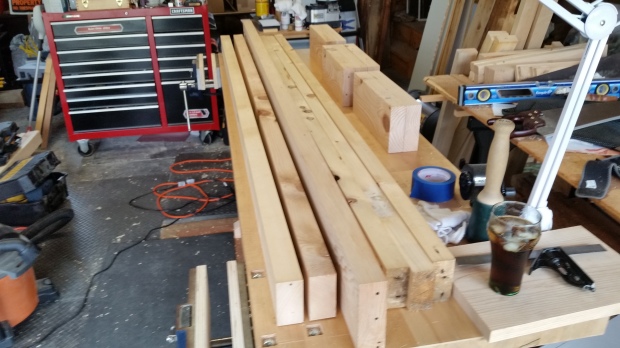Welcome back to The Apartment Woodworker!
This week, I will be rounding out the workshop tour with an in-depth look at the set of hand planes that I’ve come to know and love. Just like always, I won’t be using brand names in any description. After all, only one of my planes is a premium brand (the large router plane; thanks, Mom!) and everything else is at best a mid-budget brand. If you are here looking for hand tool porn, you are still in the wrong place.

From left to right: No. 5 1/2, No. 4 1/2, No. 4, low angle block, large router, small router, small chisel, small shoulder, trimming.
Every woodworker loves planes, even woodworkers who don’t use hand tools, and for good reason: planes are the most beautiful and complicated (and expensive) hand tools in the woodworker’s arsenal. From straightening and squaring rough stock to refining the fit of a joint to preparing the final piece for finishing, hand planes are essential at every step of furniture building. Even the most die-hard power tool enthusiast still needs at least a block plane.
Ownership of a hand plane is sort of endothermic. Only through consistent use and maintenance will a plane (and the woodworker using the tool) reach full potential. Be it a premium modern plane or a rehabilitated antique-store find, “up and running” is just the first step in the lifelong maturity and growth of tool and user alike. Once the sole is flat and the iron is sharp, the real fun begins. Plus, S4S’ing a piece of 12/4 ash is excellent exercise.
In my hand-tool woodworking, I quickly developed a preference for two particular planes: the #5 1/2 jack plane and the #4 bench plane. The #5 1/2 is plenty long enough for jointing, the #4 is plenty short enough for smoothing, and those two planes will touch every single piece of wood in every single project. I definitely use my other planes (for instance, I’m very fond of my large router plane, and the # 4 1/2 is “super tuned” for smoothing), but the #5 1/2 and the #4 form the foundation of my tool chest. It’s true that sometimes I struggle when edge jointing thin stock, because the #5 1/2 is rather too heavy and tippy and the #4, though thinner and lighter, is probably too short. Other times, flattening very long boards is a chore because even the #5 1/2 is too short. Generally, though, these two planes (and a block plane) give me everything I need to prepare all six faces of a board (faces, sides and ends) for joinery and finishing.
As an aside, I know quality hand planes are expensive and I’m not advocating that any beginner woodworker go out and spend a fortune on premium versions of the planes shown above. Truth be told, each plane has its limitations and I have made compromises for lack of space. As always, stick to your budget and figure out what works for you. If you are dying for a recommendation, though, first go out and buy a regular home center block plane. Learn how to sharpen it and adjust it. Then, make your second hand plane a decent quality #5, which I guarantee will get the job done. After that, get a small router plane and hand cut a housing joint. It will change your life.
So, that’s it for the “this is my apartment workshop and these are my tools” portion of The Apartment Woodworker. I purposely didn’t bore you with my straightedges and other miscellany and I hope you have enjoyed the tour. Next time, I hope to share with you a silly little personal project that was a little bit about necessity and a lot about testing the capabilities of the Milkman’s Workbench.
By the way, Happy Halloween to everyone! Do yourself a favor and treat your Saturday hangover to a Netflix binge on Supernatural. It’s still an amazingly entertaining show, even though it jumped the shark like a billion years ago.
JPG



James you have a lovely workshop and an impressive collection of hand planes! I got so inspired after reading this post and I’m planning on getting myself a few more hand planes myself. Appreciate what you’re doing here with your blog man! Keep going!
LikeLike